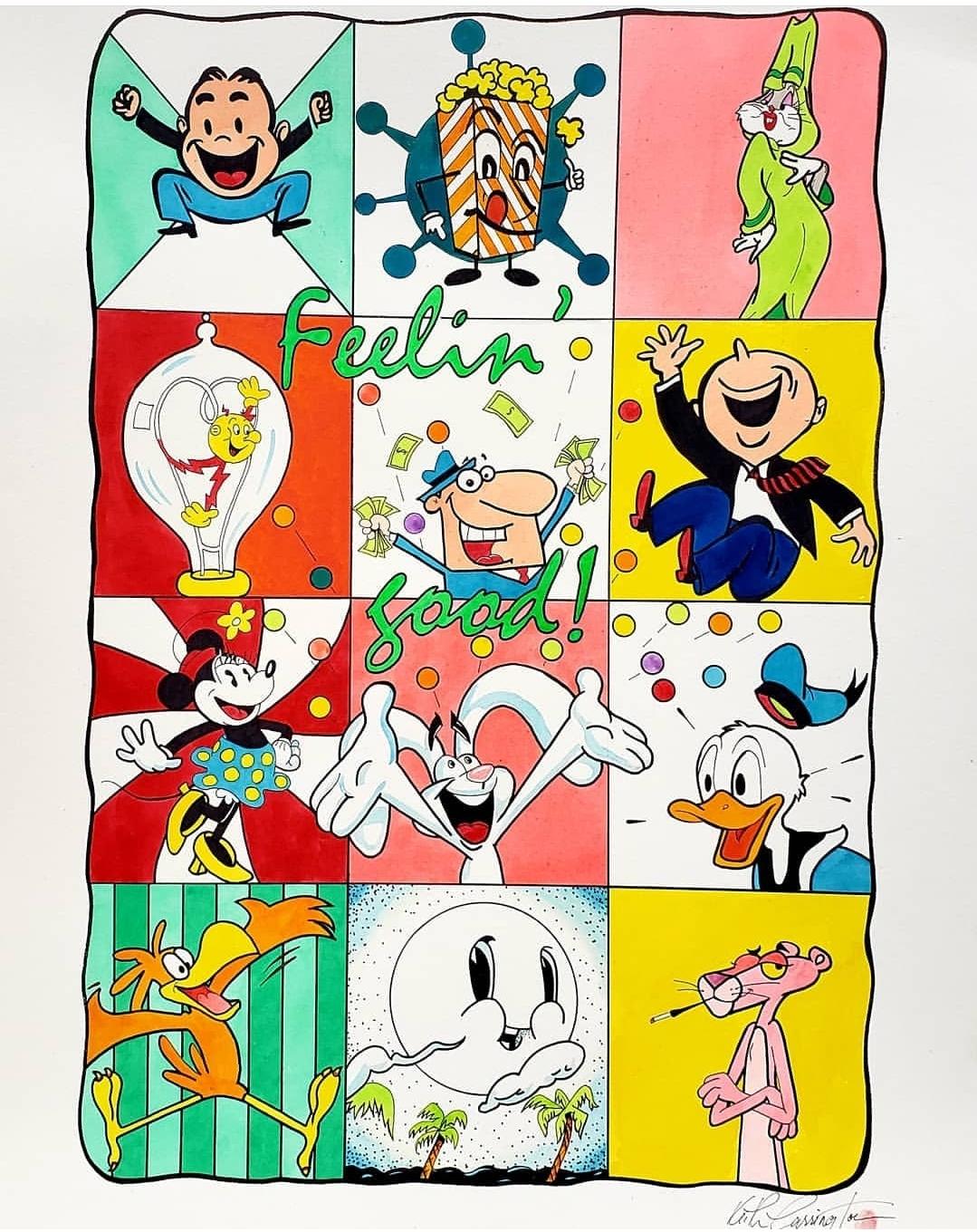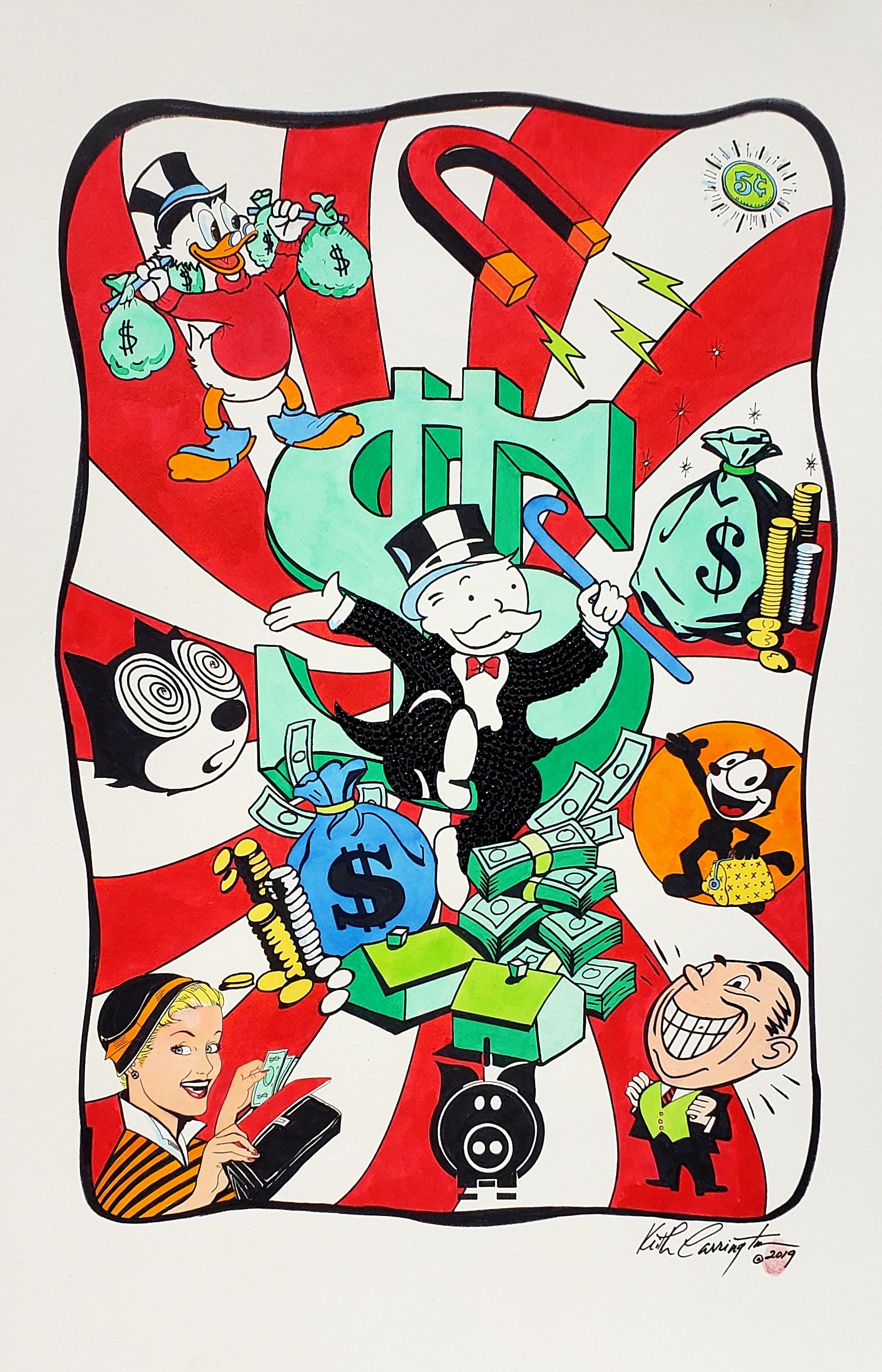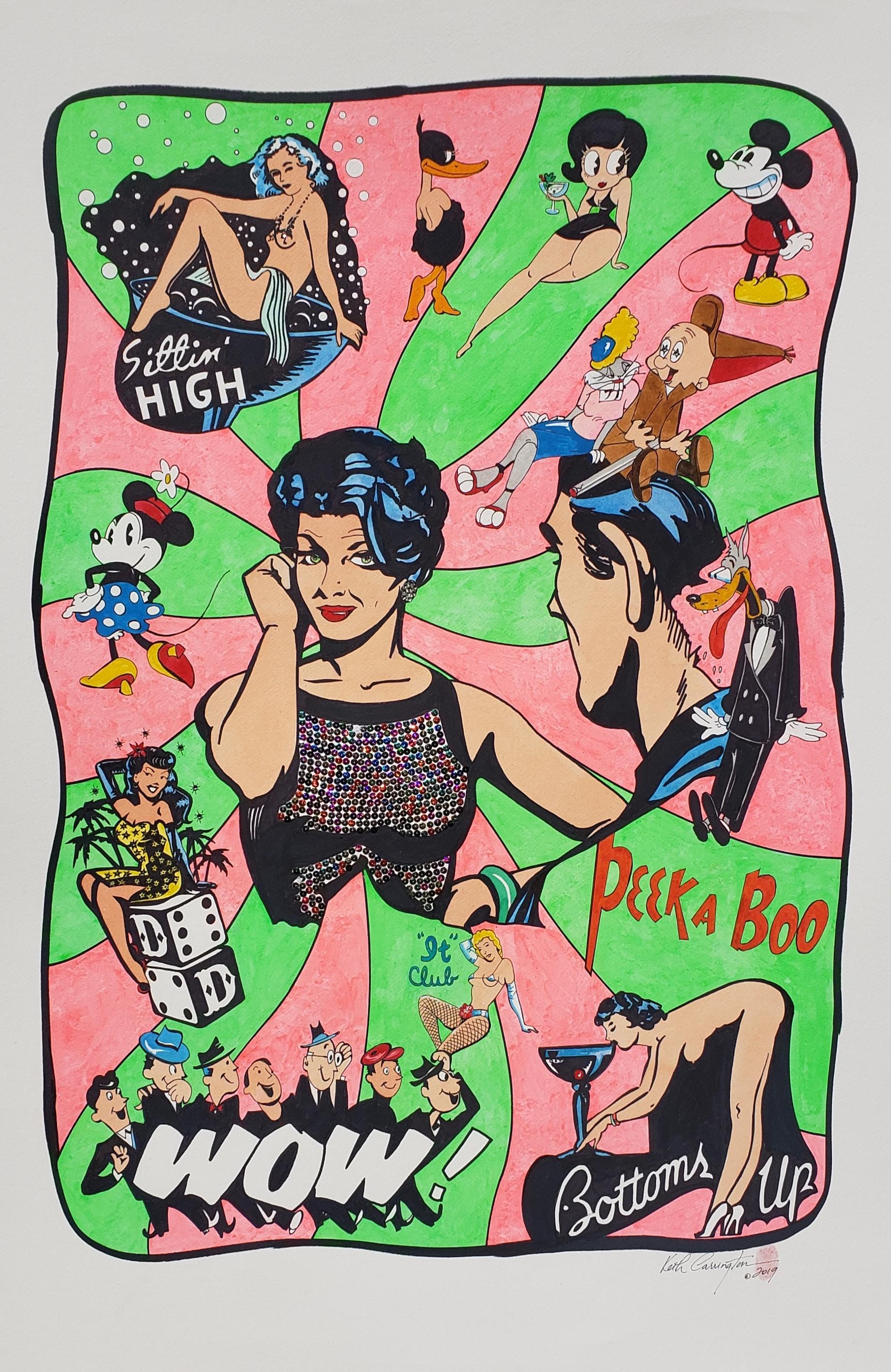Items Similar to Original Fashion Design Illustration Watercolor Painting Laura Ashley Designer
Want more images or videos?
Request additional images or videos from the seller
1 of 7
Roz JenningsOriginal Fashion Design Illustration Watercolor Painting Laura Ashley Designerc. 2000's
c. 2000's
About the Item
Original Fashion Design Illustration
by Roz Jennings, British
watercolor and ink on card, unframed
size: 12 x 8.25 inches
condition: very good
A beautifully colorful and characterful original artwork by British fashion designer, Roz Jennings. We have several works by this artist for sale and whilst they look fabulous on their own, they also make great pairs or even larger group collections on the wall. Wonderful unique artwork for so many interiors and spaces within the home.
We can combine shipping on any number of these (ie: just one shipping however many are bought together).
Roz Jennings trained in fashion at Newcastle Polytechnic (now the University of Northumbria). She graduated in the 1970s.
After graduating Roz launched her own fashion label “ROZ”, and sold her original designs through independent fashion boutiques of the day including Elle in Newcastle and Meander in Durham.
After moving to London, Roz worked as a fashion illustrator at Rowes of Bond St, and, most notably, Laura Ashley in Sloane Street.
Roz’s original illustrations for Laura Ashley exude the 'Dudu look' or ‘Biba look’ associated with the London fashion brand Biba and supermodel Twiggy. In 2008 Laura Ashley Home Store produced a fashion illustrations calendar featuring nine of Roz's original drawings
Roz went on to open her own shop “CLOZO” in Camden Passage, Islington, which specialised in vintage clothing.
- Creator:Roz Jennings (British)
- Creation Year:c. 2000's
- Dimensions:Height: 12 in (30.48 cm)Width: 8.25 in (20.96 cm)
- Medium:
- Movement & Style:
- Period:
- Condition:
- Gallery Location:Cirencester, GB
- Reference Number:1stDibs: LU50938735212

About the Seller
5.0
Platinum Seller
These expertly vetted sellers are 1stDibs' most experienced sellers and are rated highest by our customers.
Established in 1989
1stDibs seller since 2016
3,414 sales on 1stDibs
Typical response time: 2 hours
- ShippingRetrieving quote...Ships From: Cirencester, United Kingdom
- Return PolicyA return for this item may be initiated within 3 days of delivery.
More From This SellerView All
- Original Fashion Design Illustration Watercolor Painting Laura Ashley DesignerBy Roz JenningsLocated in Cirencester, GloucestershireOriginal Fashion Design Illustration by Roz Jennings, British watercolor and ink on card, unframed size: 12 x 8.25 inches condition: very good A beautifully colorful and characterfu...Category
Late 20th Century Pop Art Figurative Paintings
MaterialsInk, Watercolor
- Original Fashion Design Illustration Watercolor Painting Laura Ashley DesignerBy Roz JenningsLocated in Cirencester, GloucestershireOriginal Fashion Design Illustration by Roz Jennings, British watercolor and ink on card, unframed size: 12 x 8.25 inches condition: very good A beautifully colorful and characterfu...Category
Late 20th Century Pop Art Figurative Paintings
MaterialsInk, Watercolor
- Original Fashion Design Illustration Watercolor Painting Laura Ashley DesignerBy Roz JenningsLocated in Cirencester, GloucestershireOriginal Fashion Design Illustration by Roz Jennings, British watercolor and ink on card, unframed size: 12 x 8.25 inches condition: very good A beautifully colorful and characterfu...Category
Late 20th Century Pop Art Figurative Paintings
MaterialsInk, Watercolor
- Original Fashion Design Illustration Watercolor Painting Laura Ashley DesignerBy Roz JenningsLocated in Cirencester, GloucestershireOriginal Fashion Design Illustration by Roz Jennings, British watercolor and ink on card, unframed size: 12 x 8.25 inches condition: very good A beautifully colorful and characterfu...Category
Late 20th Century Pop Art Figurative Paintings
MaterialsInk, Watercolor
- Original Fashion Design Illustration Watercolor Painting Laura Ashley DesignerBy Roz JenningsLocated in Cirencester, GloucestershireOriginal Fashion Design Illustration by Roz Jennings, British watercolor and ink on card, unframed size: 12 x 8.25 inches condition: very good A beautifu...Category
Late 20th Century Pop Art Figurative Paintings
MaterialsInk, Watercolor
- Original Fashion Design Illustration Watercolor Painting Laura Ashley DesignerBy Roz JenningsLocated in Cirencester, GloucestershireOriginal Fashion Design Illustration by Roz Jennings, British watercolor and ink on card, unframed size: 12 x 8.25 inches condition: very good A beautifully colorful and characterfu...Category
Late 20th Century Pop Art Figurative Paintings
MaterialsInk, Watercolor
You May Also Like
- Feelin Good Ink On PaperBy Keith CarringtonLocated in Delray Beach, FLFeelin Good, Ink on archival paper. Keith Carrington’s experiences have led him to express his talents through the fluid & exacting mediums of watercolor and ink. He has honed his s...Category
2010s Pop Art Figurative Paintings
MaterialsInk, Watercolor, Archival Paper
- Féminine Mystique Ink on PaperBy Keith CarringtonLocated in Delray Beach, FLFeminine Mistique, ink on archival paper. Keith Carrington’s experiences have led him to express his talents through the fluid & exacting mediums of watercolor and ink. He has honed...Category
2010s Pop Art Figurative Paintings
MaterialsWatercolor, Ink, Archival Paper
- I Am Money MagnetBy Keith CarringtonLocated in Delray Beach, FLI am money magnet, Ink on archival paper. Keith Carrington’s experiences have led him to express his talents through the fluid & exacting mediums of watercolor and ink. He has honed his skills, clarified his vision, experimented, explored and expanded his expression steadily over the years, the results of which thus far culminate here. Keith’s extensive travels have roots in the luminous quality of his work, eminently holding the unlimited possibilities of beauty and significance. Keith’s most recent paintings combine original comic book renderings that his mother did for Disney et al. and reinterprets them effectively combining the past with present energies and infuses his enthusiasm into these dynamic pieces that you see here today. GROUP EXHIBITIONS 2017, 2018 Renata Fine Arts, West Palm Beach, FL 2015, 2016 Renata Fine Arts, Hudson, New York 2013 @60inches New York, NY 2012 @60inches New York, NY curated sale with Harry Heisman 2011 KL/Karen Lynne Gallery, Boca Raton, Florida & Beverly Hills, California 2003 Dupont Gallery, Milwaukee Wisconsin 1994 Jack Shainman Gallery, New York, NY 1994 The Roger Smith Gallery, New York, NY 1993 Ambassador Galleries, New York, NY 1992 Elaine Benson Gallery, Bridgehampton, New York 1983 Manor House Gallery, Rhinebeck, New York SOLO EXHIBITIONS 2014, 2015 C. Bell, Palm Beach, Florida 2010 Luxe Energy Aesthetics, West Palm Beach, Florida 1995 Time Warner Publishing, New York, NY 1991 Imperial Hotel Gallery, Chestertown, Maryland 1990 National Symphony Show House, Washington, DC 1988, 1987 International Jumping Derby, Jockey Club, Newport, Rhode Island 1986 Elijah Locke House, Rye Beach, New Hampshire 1984 Washington Design Center, Washington, D.C. SELECTED CORPORATE COLLECTIONS Bovis Inc., New York, NY The Kiplinger Collection, Washington, D.C. The International Monetary Fund, Washington, D.C. Hopkins & Sutter, Washington, D.C. McKenna, Conner, & Cuneo, Washington, D.C. Oliver T. Carr Company, Alexandria, Virginia SELECTED PRIVATE COLLECTIONS RuPaul, Beverly Hills, California Kelly Klein, New York, NY Governor & Mrs. Bruce Sundlun, Providence, Rhode Island Mr. & Mrs. William Aylward...Category
2010s Pop Art Figurative Paintings
MaterialsInk, Watercolor, Archival Paper, Sequins
- Look Jane Ink Watercolor on PaperBy Keith CarringtonLocated in Delray Beach, FLLook Jane, ink, watercolor on archival paper. From the new series. Jane and Dick conversation. Keith Carrington’s experiences have led him to express his talents through the fluid &...Category
2010s Pop Art Figurative Drawings and Watercolors
MaterialsWatercolor, Archival Paper, Ink
- Golf Swing with Psychedelic Butterfly, Funky Chickens and Groovy FlowersBy Abe GurvinLocated in Miami, FLThis is dreamy psychedelic depiction of a golfer hitting a ball in a psychedelic wonderland of chickens moons, starts and groovy flowers Gurvin was Graphic Designer & Visual artist Abe Gurvin...Category
1970s Pop Art Figurative Drawings and Watercolors
MaterialsWatercolor, Charcoal
- The Abduction of the Sabine Women , a Renaissance drawing by Biagio PupiniLocated in PARIS, FRThis vigorous drawing has long been attributed to Polidoro da Caravaggio: The Abduction of the Sabine Women is one of the scenes that Polidoro depicted between 1525 and 1527 on the façade of the Milesi Palazzo in Rome. However, the proximity to another drawing inspired by this same façade, kept at the Ecole des Beaux-Arts, and to other drawings inspired by Polidoro kept at the Musée du Louvre, leads us to propose an attribution to Biagio Pupini, a Bolognese artist whose life remains barely known, despite the abundant number of drawings attributed to him. 1. Biagio Pupini, a Bolognese artist in the light of the Roman Renaissance The early life of Biagio Pupini, an important figure of the first half of the Cinquecento in Bologna - Vasari mentions him several times - is still poorly known. Neither his date of birth (probably around 1490-1495) nor his training are known. He is said to have been a pupil of Francesco Francia (1450 - 1517) and his name appears for the first time in 1511 in a contract with the painter Bagnacavallo (c. 1484 - 1542) for the frescoes of a church in Faenza. He then collaborated with Girolamo da Carpi, at San Michele in Bosco and at the villa of Belriguardo. He must have gone to Rome for the first time with Bagnacavallo between 1511 and 1519. There he discovered the art of Raphael, with whom he might have worked, and that of Polidoro da Caravaggio. This first visit, and those that followed, were the occasion for an intense study of ancient and modern art, as illustrated by his abundant graphic production. Polidoro da Caravaggio had a particular influence on the technique adopted by Pupini. Executed on coloured paper, his drawings generally combine pen, brown ink and wash with abundant highlights of white gouache, as in the drawing presented here. 2. The Abduction of the Sabine Women Our drawing is an adaptation of a fresco painted between 1525 and 1527 by Polidoro da Caravaggio on the façade of the Milesi Palace in Rome. These painted façades were very famous from the moment they were painted and inspired many artists during their stay in Rome. These frescoes are now very deteriorated and difficult to see, as the palace is in a rather narrow street. The episode of the abduction of the Sabine women (which appears in the centre of the photo above) is a historical theme that goes back to the origins of Rome and is recounted both by Titus Livius (Ab Urbe condita I,13), by Ovid (Fasti III, 199-228) and by Plutarch (II, Romulus 14-19). After killing his twin brother Romus, Romulus populates the city of Rome by opening it up to refugees and brigands and finds himself with an excess of men. Because of their reputation, none of the inhabitants of the neighbouring cities want to give them their daughters in marriage. The Romans then decide to invite their Sabine neighbours to a great feast during which they slaughter the Sabines and kidnap their daughters. The engraving made by Giovanni Battista Gallestruzzi (1618 - 1677) around 1656-1658 gives us a good understanding of the Polidoro fresco, allowing us to see how Biagio Pupini reworked the scene to extract this dynamic group. With a remarkable economy of means, Biagio Pupini takes over the left-hand side of the fresco and depicts in a very dense space two main groups, each consisting of a Roman and a Sabine, completed by a group of three soldiers in the background (which seems to differ quite significantly from Polidoro's composition). The balance of the drawing is based on a very strongly structured composition. The drawing is organised around a median vertical axis, which runs along both the elbow of the kidnapped Sabine on the left and the foot of her captor, and the two main diagonals, reinforced by four secondary diagonals. This diamond-shaped structure creates an extremely dynamic space, in which centripetal movements (the legs of the Sabine on the right, the arm of the soldier on the back at the top right) and centrifugal movements (the arm of the kidnapper on the left and the legs of the Sabine he is carrying away, the arm of the Sabine on the right) oppose each other, giving the drawing the appearance of a whirlpool around a central point of support situated slightly to the left of the navel of the kidnapper on the right. 3. Polidoro da Caravaggio, and the decorations of Roman palaces Polidoro da Caravaggio was a paradoxical artist who entered Raphael's (1483 - 1520) workshop at a very young age, when he oversaw the Lodges in the Vatican. Most of his Roman work, which was the peak of his career, has disappeared, as he specialised in facade painting, and yet these paintings, which are eminently visible in urban spaces, have influenced generations of artists who copied them abundantly during their visits to Rome. Polidoro Caldara was born in Caravaggio around 1495-1500 (the birthplace of Michelangelo Merisi, known as Caravaggio, who was born there in 1571), some forty kilometres east of Milan. According to Vasari, he arrived as a mason on the Vatican's construction site and joined Raphael's workshop around 1517 (at the age of eighteen according to Vasari). This integration would have allowed Polidoro to work not only on the frescoes of the Lodges, but also on some of the frescoes of the Chambers, as well as on the flat of Cardinal Bibiena in the Vatican. After Raphael's death in 1520, Polidoro worked first with Perin del Vaga before joining forces with Maturino of Florence (1490 - 1528), whom he had also known in Raphael's workshop. Together they specialised in the painting of palace façades. They were to produce some forty façades decorated with grisaille paintings imitating antique bas-reliefs. The Sack of Rome in 1527, during which his friend Maturino was killed, led Polidoro to flee first to Naples (where he had already stayed in 1523), then to Messina. It was while he was preparing his return to the peninsula that he was murdered by one of his assistants, Tonno Calabrese, in 1543. In his Vite, Vasari celebrated Polidoro as the greatest façade decorator of his time, noting that "there is no flat, palace, garden or villa in Rome that does not contain a work by Polidoro". Polidoro's facade decorations, most of which have disappeared as they were displayed in the open air, constitute the most important lost chapter of Roman art of the Cinquecento. The few surviving drawings of the painter can, however, give an idea of the original appearance of his murals and show that he was an artist of remarkable and highly original genius. 4. The façade of the Milesi Palace Giovanni Antonio Milesi, who commissioned this palace, located not far from the Tiber, north of Piazza Navona, was a native of the Bergamo area, like Polidoro, with whom he maintained close friendly ties. Executed in the last years before the Sack of Rome, around 1526-1527, the decoration of Palazzo Milesi is considered Polidoro's greatest decorative success. An engraving by Ernesto Maccari made at the end of the nineteenth century allows us to understand the general balance of this façade, which was still well preserved at the time. The frescoes were not entirely monochrome, but alternated elements in chiaroscuro simulating marble bas-reliefs and those in ochre simulating bronze and gold vases...Category
16th Century Old Masters Figurative Drawings and Watercolors
MaterialsInk, Gouache, Pen
Recently Viewed
View AllMore Ways To Browse
Designers Originals Vintage
Original Fashion Designs
Fashion Labels Vintage
Retro Fashion Designers
Vintage Fashion Brands
Vintage Fashion Brand
Vintage Designer Home
Retro Fashion Brands
Vintage Illustrations
Designer Vintage London
Vintage Illustration Art
Vintage Original Illustration
Vintage British Fashion
Original Vintage Illustration Art
Vintage Card Art
Vintage Fashion Wall Art
Space Illustration Vintage
Space Vintage Illustrations





